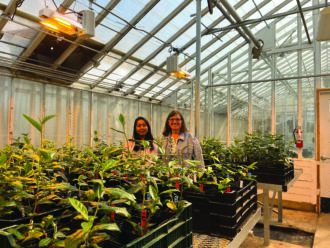Tea is one of the most popular drinks in the world, second only to water in consumption. In America, you can find it in more than 80 percent of households. Finding it growing in U.S. soil is another story. Tea is produced on less than 100 acres in America, mostly in Hawaii and the South.
“And honestly, there’s no reason tea crops can’t flourish throughout the nation, including the West,” said Srijana Shrestha, a horticulture graduate student at Washington State University. “Tea is a cousin to camellias, which are grown in gardens across the country. The only barrier is lack of tea plant material and knowledge of tea plant propagation.”
Shrestha and her major professor, Dr. Carol Miles, are working to change that. With support from local growers and a Western SARE grant, Shrestha and Miles are developing new techniques to propagate 14 tea varieties so they have plants to test for suitability for Western climates. The project builds on successful experiments Shrestha conducted last year.
“In the earlier work, I used different levels of light, shade, heat and humidity to propagate one tea variety in the greenhouse,” she explained. “My success rate was over 90 percent, and now I’m moving those plants outside to test fields and increasing the number of varieties.”
All 14 varieties in the new project, like virtually all tea plants, could be made into teas that are black, green and everything in between because “color” happens during the processing not the cultivation. Tea leaves are processed commercially but can also be processed at home with a little sun and oven heat.
“That’s one reason tea plants could benefit backyard gardeners as well as commercial growers,” Shrestha said. “Imagine harvesting tea leaves along with your herbs and produce!”
Tea can be tricky to establish, but once they take hold the bushy, waist-high plants can produce flavorful leaves for up to for 100 years. Tea plants tend to prefer warm conditions, but Shrestha says growers and gardeners can use wind breaks, row covers and other strategies to help plants stay warm in cool climates. In the United States, tea can be grown in the USDA Hardiness zones 7, 8, 9 and 10.
Shrestha and her team will provide hands-on training on tea-cutting propagation and offer cuttings to local nurseries. They will also post all their tea plant propagation information on their website.
“America is the third-largest importer of tea, which continues to grow in popularity and demand in the United States,” she said. “With the right techniques, we can propagate tea plants that thrive in the West and throughout the nation and help local nurseries and growers become part of this emerging industry.”
View Related SARE Grant:
- Tea Plant Propagation for Nursery Production (GW24-013)
